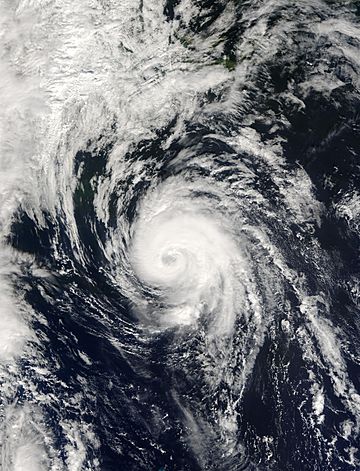Hurricane Juan facts for kids
| Category 2 hurricane (SSHWS/NWS) | |

Hurricane Juan approaching Nova Scotia as a 100mph hurricane
|
|
| Formed | September 24, 2003 |
|---|---|
| Dissipated | September 29, 2003 |
| Highest winds | 1-minute sustained: 105 mph (170 km/h) |
| Lowest pressure | 969 mbar (hPa); 28.61 inHg |
| Fatalities | 4 direct, 4 indirect |
| Damage | $200 million (2003 USD) |
| Areas affected | Atlantic Canada (primarily Nova Scotia and Prince Edward Island) |
| Part of the 2003 Atlantic hurricane season | |
Hurricane Juan was a powerful storm that hit Atlantic Canada in September 2003. It was the sixth hurricane to form during the 2003 Atlantic hurricane season. Juan caused a lot of damage, especially in Nova Scotia and Prince Edward Island. It was one of the most expensive hurricanes ever to hit Nova Scotia. The storm sadly led to 8 deaths and caused about $200 million in damage. Hurricane Juan only affected Canada directly.
Contents
How Hurricane Juan Formed and Moved
Hurricane Juan started as a "tropical wave" off the coast of Africa. A tropical wave is like a ripple in the atmosphere that can sometimes grow into a storm.
From Wave to Tropical Depression
On September 24, 2003, this tropical wave became a "Tropical Depression". This is the first official stage of a tropical storm. It means the storm has a clear center of low pressure and some organized thunderstorms.
Becoming a Tropical Storm
The very next day, September 25, 2003, Juan grew stronger and became a "Tropical Storm". At this point, it was just northeast of Bermuda. When a storm becomes a tropical storm, its winds are faster, usually between 39 and 73 miles per hour (63 to 118 km/h).
Growing into a Hurricane
Experts first thought Juan would only reach tropical storm strength. But they were wrong! On September 26, 2003, Juan became a "Category 1 hurricane". This means its winds were at least 74 miles per hour (119 km/h). The day after, it got even stronger, becoming a "Category 2 hurricane" as it moved closer to Nova Scotia. A Category 2 hurricane has winds between 96 and 110 miles per hour (154 to 177 km/h).
Landfall and Dissipation
On September 29, Hurricane Juan made landfall, meaning it hit the land, in Halifax, Nova Scotia. Its winds were very strong, about 100 miles per hour (160 km/h). After hitting land, Juan moved further inland and slowly lost its power, eventually breaking apart.
Why Hurricane Juan's Name Was Retired
When a hurricane causes a lot of damage or deaths, its name is "retired". This means the name will never be used again for another hurricane in the Atlantic Ocean. This is done to remember the serious impact of the storm and to avoid confusion in the future.
Because Hurricane Juan caused so much damage and loss of life, its name was retired. The name "Joaquin" was chosen to replace "Juan" on the list of hurricane names for 2009.
|
Tropical cyclones of the 2003 Atlantic hurricane season |
|||||||||||||||||||||||||||||||||||||
|
|
||||||||||||||||||||||||||||||||||||
|
|
|||||||||||||||||||||||||||||||||||||
Images for kids
-
Damage to the Halifax Public Gardens after Hurricane Juan
See also
 In Spanish: Huracán Juan para niños
In Spanish: Huracán Juan para niños






